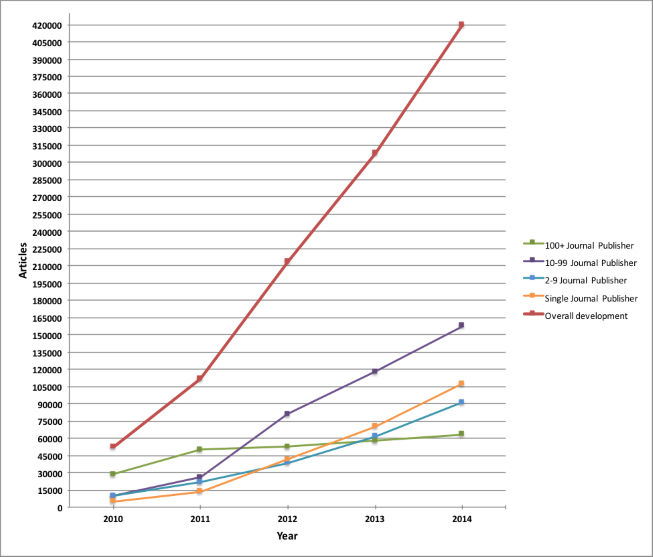Predatory journals have been plaguing the academic publishing world for many years, and the problem is getting worse. As a recent Nature article revealed, even experienced researchers get scammed by them sometimes. Inexperienced, researchers, especially from non-English speaking countries, are easy prey.

The rise of predatory publishing. From Wikipedia.
Take, for instance, this researcher who recently sent me his paper after it has been published in a predatory pay-to-publish open access journal. He saw the fact that his paper was accepted a validation of his ideas. In reality, his paper was badly flawed, its main conclusions based on naive mistakes that would have been pointed out by a competent referee (or even editor!) during a normal peer review process. But predatory journals are not interested in rejecting papers; they are into maximizing their revenue.
There used to be a wonderful list of predatory, maintained by Jeffrey Beall. Unfortunately, Beall decided to take down his Web site, thus depriving us of an essential resource.
In my response to the aforementioned researcher, I listed a few criteria by which a predatory publisher can be identified. I know, I know, such lists exist, but these are characteristics that I personally consider important:
- Open access: Obviously not all open access journals are predatory, and there are a few predatory journals that are not open access. But the vast majority are, since they (for obvious reasons) cannot build a real subscriber base, so their main or sole source of revenue is author fees.
- Publication fee that is often too low to cover the real costs of publishing: The publication fees charged by legitimate journals to publish papers, e.g., with open access easily run up to a thousand dollars or more. It indeed costs that much to guide a paper through the peer review process and then prepare it for publication through a proper copy editing and proofreading process.
- No real history to the journal: Predatory journals tend to be new, with few (if any) notable papers.
- Low quality papers with uncorrected English (typos, grammatical mistakes, incomprehensible sentences) from unknown authors: All it takes is one peek at papers with very bad quality English to know that the journal has no real editorial staff or policies and they publish anything so long as the fees are paid.
- Many papers that do not appear on arxiv.org, as having been rejected there for quality reasons: If the journal specializes in an area that is covered by arXiv, e.g., theoretical physics or astrophysics, yet the papers published by it do not appear on arXiv, that is an almost certain indicator that it is a journal preferred by cranks and crackpots, whose submissions are rightfully rejected by arXiv moderators.
- An unusually large number (often hundreds) of young journals from the same publisher: Predatory publishers tend to launch a very large number of journals, e.g., dozens if not hundreds of “British journal of this” or “American journal of that” or similar names designed to suggest legitimacy. (Lately, some predatory publishers even went so far as to hijack the name of obscure but distinguished journals, e.g., from Eastern Europe.)
- No association with any known, reputable research organization, publication house or university: Reputable, top quality journals are usually associated with a research institution. For instance, Physical Review is published by the American Physical Society; Science is published by the American Association for the Advancement of Science. A variant on this theme is when the journal is, in fact, associated with an institution but the institution itself is phony.
This list of criteria is, of course, not complete. But I am quite certain that any journal that scores high on all seven of these is, in fact, a predatory journal.